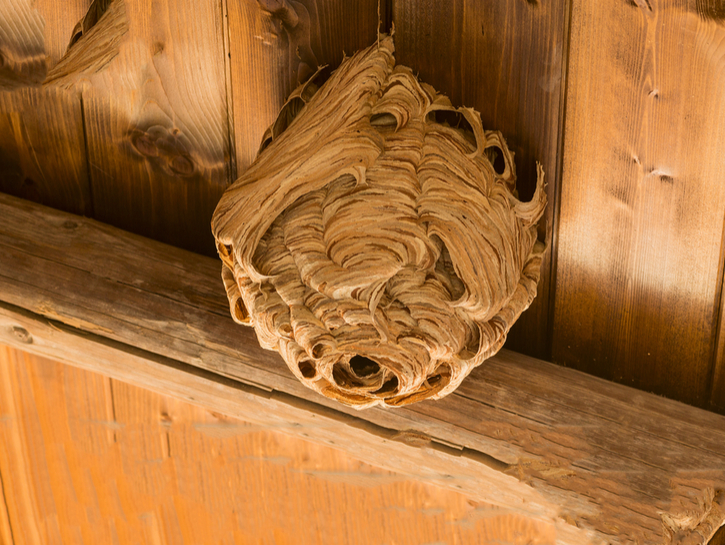If you’ve got a wasp nest on your property, you’re going to want to get rid of it fast — and without getting stung. But where do you start? Although approaching this task can seem risky and anxiety-inducing, ridding your property of wasps nests is doable, and here’s how:
First And Foremost: Be Careful
To remove a wasp nest, extreme caution is required. If you have an allergy to wasp stings, you should not be removing a nest yourself. You might not be sure whether you have an allergy or not, so consider scheduling an allergy test with your doctor if you are unsure. Also, make sure there are no other people in the area in case the removal doesn’t go smoothly.
Removing A Wasp Nest
Before you go crazy and start swinging a baseball bat at the nest nest, you’ll want to consider the safest way to get rid of it. Ultimately, calling an exterminator is usually the best bet. They remove wasp’s nests regularly and know the most efficient and safest way to do it. You can save a few dollars by doing it yourself, but you’ll spare yourself potential headaches by getting a professional.
If you’re already mentally committed to doing it yourself, make sure to follow these steps:

Leonid Eremeychuk/Shutterstock
Gear Up With Protective Clothing
When you go to remove a wasp’s nest, you’ve got to suit up. Make sure that as little skin is exposed as possible. The more skin that’s covered, the less chance you have of being stung.
Wear thick clothing such as jeans, high boots and a hoodie. Wrap a scarf around your face (underneath the eyes) and put some goggles and gloves on if you have them. You might scare the neighbors, but fully covering yourself will make the wasp-removal process a much less painful one.
Make A Plan Of Attack
Evaluate the area surrounding the wasp’s nest before you start the removal process. If the nest is located in an out-of-reach spot, such as in a high tree or the second-story of your home, don’t climb up on a ladder. This makes the situation more dangerous for you, and you should only attempt to dispose of a wasp nest if it is within easy reach. If it’s too high up for you to get access without a ladder, just call an exterminator to take care of it.
Timing is important when it comes to getting rid of a wasp’s nest. It’s best to tackle the nest as early in the year as possible before the wasps have procreated to full capacity and possibly even expanded to make more nests. If you’ve just noticed the nest in the fall, you might not need to get rid of it at all because the cold temperatures through the winter will kill the hive. In that case, you’ll simply need to dispose of the nest once the insects have died. Wasps are least active at night, so plan to get rid of the nest in the evening or early morning.
Before you begin, it’s also important to plan an escape route. When you spray the nest, the wasps might start flying out and can swarm you. If this happens, you need to know how to get away quickly.

Julia Strochilina/Shutterstock
Spray The Nest
Pesticide sprays tend to be the most effective for getting rid of wasps. You’ll need to spray the nest for 10 to 15 seconds, then quickly leave the area and let it settle for at least a day. Examine the nest from a safe distance the following day, and if you still see wasp activity, repeat the process once more. Make sure the wasps are all dead before knocking down the nest with a long stick. Use gloves when you remove the nest from your property, and dispose of it quickly, along with all the broken pieces and dead wasps — they will all be infected with poisonous pesticide now.
Prevention Is The Best Option
It’s always best to prevent a problem before it even becomes a problem in the first place. There are some easy ways to stop wasps from even building nests around your home in the first place:
- Wasps are attracted to things that are sweet, so don’t leave food out or trash cans uncovered.
- Regularly inspect your home for areas where wasps could form a nest, such as broken siding or poorly insulated patio roofs. Seal these areas.
- Believe it or not, there’s actually decoy wasps that you can purchase or make yourself. Wasps are very territorial, so when they see what looks like a wasps nest on your property, they won’t build a nest within 200 feet of it. These aren’t usually the prettiest fixtures, but they’ll do the trick if you’re paranoid about wasps moving in.
- Knock down empty nests during the winter. Although wasps won’t move back into an abandoned nest, some species of wasps will build a new nest on top of an old one.
- There are many natural options that prevent wasps from making nests. You can use plants or essential oils such as thyme, citronella, eucalyptus, spearmint, peppermint and wormwood.
